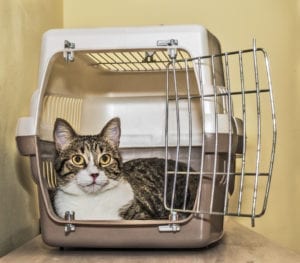Crate Training Cats? Absolutely.

Crate training cats doesn’t have to be akin to herding them. And, once your kitty is good to go, you may even find that your kitty enjoys his or her private den.
Why You Should Crate Train Your Cat
Beyond commonplace travel, crate training your cat may reduce his or her fear and anxiety in the case of a disaster or emergency. The creation of a crate-based safe haven will encourage your cat to enter the crate willingly, and end the association of the crate and it’s strange smells and slippery floor as a punishment or something to fear.
How To Get Started
First, you’ll need to be certain that your crate is the right size for your cat. It should be big enough for to stand up and comfortably turn around in. If it’s too small, your cat will feel trapped and, if it’s too big, he or she may be jostled around during transport, which is scary and disconcerting.
Once you’ve got the right crate for your kitty, find an easily accessible, out of the way spot (that will still interest your cat for its views and intrigue), line the crate with something soft (towels, blankets, etc.) and throw a blanket over the top to create a soft and inviting den. Cats are natural hunters and should be drawn to the soft, dark, oasis you have created for him or her.
Moving Forward
If your cat doesn’t enter the crate shell on his or her own volition, you may have to buckle down with a reward system. Some cat owners find success with clicker training, while others simply motivate their cats with (healthy) treat placement, Hansel and Gretel style.
Here are a few tricks and next steps for crate training cats…
Crate Training Cats Proves Worthy
You may find different ways to get creative with your own cat while figuring out how to crate train him or her. The bottom line is that, after this most worthwhile endeavor, your cat will learn to travel without stress or anxiety. Call us with any questions or concerns and good luck!
Share This Article
About
Schertz Animal Hospital
Since 1976, Schertz Animal Hospital has offered the greater San Antonio area outstanding pet care. Our state-of-the-art animal hospital in Schertz, TX compliments our stress-free handling and experienced veterinary staff. Make an appointment online or give us a call at (210) 659-0345 today!
